Install Mains or Crosses First?
I have been asked countless times over my career if I install mains or crosses first. Of course, like all of us, I’ve always begun with the main strings. But, I must admit, my curiosity finally got the best of me, and I decided to try it the other way around, not really sure what I would come up with.

Is the Process any Different?
After more than 40 years of doing something a certain way, any change would be disconcerting, and this was definitely different. First, I had to decide whether I would start the crosses in the center (like I would with mains) or do them from the top down (bottom-up installation never entered my mind).
After deciding switching starting clamps around to make the process work was too time-consuming — and would open me up to string damage — I decided to go with top-down.
Once I mounted the frame, I opened up the grommets on the second and 18th cross on my Tecnifibre TFight 305 racquet so I would have a place to tie-off the crosses before main string installation (since all the tie-off holes are on mains, it allowed me to avoid the hazards of leaving starting clamps in place through the entire job).
I must admit, it felt strange to install crosses without mains already in place, and weaving mains through crosses was even more off-putting. But I made it through not once, but twice, as I’ll explain below.
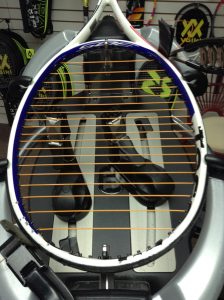
What Happened to the Frame after Cross Installation?
Stringing machines – at least mine, anyway — are not set up to properly support the frame if crosses are put in first. Even with only 33 pounds of tension, the frame was deformed, with noticeable separation from the tip, throat, and side supports. The frame became 1/2cm shorter, and almost 1cm narrower, once all the crosses were installed. I can’t imagine how bad this would have been if I had strung it at, say, 60 pounds instead.
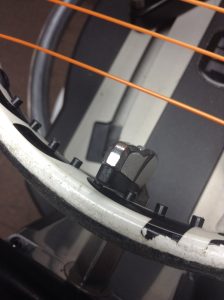
Installing the mains did not recover all the lost shape, and the frame not only measured shorter and wider, but it also looked that way, as well when compared to a traditionally strung one.
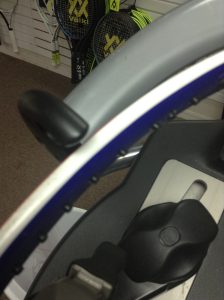
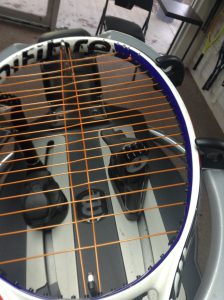
I took a DT reading on both frames, and there were differences. The traditionally strung frame had a DT of 27, right in line with what I normally get, while the “crosses first” racquet only had a DT of 25, a difference of 4# of tension (according to the ert1000).
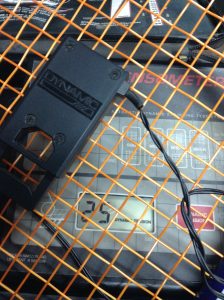
I decided to try again and increase the main string tension by the lost 4# and see what happened. The DT increased to 28, or just a touch above the normally strung racquet, but the frame still compressed and didn’t recover when the mains were put in.
As a tribute to Tecnifibre’s material quality, the frame went back into shape when the strings were removed but, once again, I don’t know if this would have been the case at a higher tension.
How Did the Racquets Play?
This was quite enlightening because I was expecting the “crosses-first” frame, with the lower DT, to have a higher launch and more depth, but I was sorely mistaken.
The racquet felt mushy and dead, and the ball almost refused to come off the strings at all. Power was nonexistent, and I had to work quite hard to make the ball do anything, from the softest volleys to harder-hit serves and groundstrokes. Like I said, it was not what I expected. Even the frame with the higher main string tension didn’t fare well, with diminished power and feel.
Would I Recommend this Process?
Due to the frame deformation alone, I wouldn’t recommend this procedure, and the poor performance doesn’t help, either. I’ll never string a racquet like this again and would not recommend it to anyone.
If you’re a racquet technician and would like to join a community of like-minded people please visit our Membership page at www.gssalliance.com/join/ to join us. Already a basic member? You’ll find an easy upgrade link on the join page to become a Premium member.
IART Premium Members have FULL access to all content and exclusive membership directories. Knowledge is power, so become a Premium member and get THAT power!

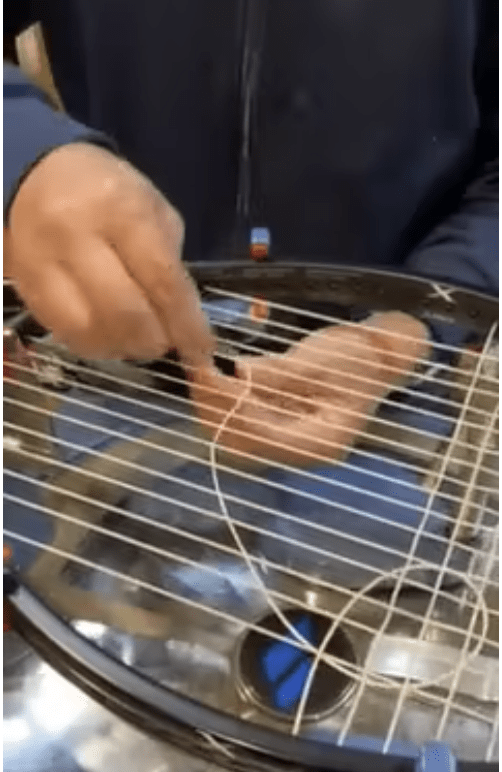
Comments (6)
This was an interesting experiment, Matt! I was concerned for your racquet though. Thanks to your curiosity, we can all put that question to rest!
Albert:
Our machines are not set up to string racquets in this manner. If the supports held the frame in both directions, it might be possible. However, the performance loss is unavoidable, I think.
We shouldn’t treat our racquets like this, anyway.
Really interesting. I think lots of people wonder about that. Do you think you would have still gotten the compression had you mounted the racket differently, say with your main mounting posts (6 and 12), and put those at 3 and 9? With a 6-point mounting machine, it may have been impossible, but makes you wonder.
Steve:
Since the frame came off of all supports, I don’t think mounting it differently would matter.
The supports are designed to limit frame expansion on main installation, not stop frame compression if crosses are installed first.
Now that I’ve tried it, no one else needs to go through it.
You’re welcome LOL
Matt
Interesting blog! I wonder if you had strung the crosses starting at the centre it would have made any different. Stringing natural gut crosses from the centre is quite common, firstly working from the centre to the top then the centre down to the throat. Just a thought!!
David, I found out (and should have known already) that the frame supports don’t hold the racquet from the inside, so it is free to compress if the crosses are installed first. I don’t think it would matter if they’re done top-down, bottom-up or center-out.
If we’re going to string this way, it would take redesigned frame supports to eliminate compression during cross installation.